Not only has coastal erosion been whittling away at The Lizard peninsula but remnants of past civilisations are disappearing along with fireside tales and forgotten soliloquies. It is the often frustrated task of archaeologists to rescue artefacts and ideas from the vanished past and weave them into a pastiche of what might have been.
A lament from Sam Turner¹ pinpoints the absence of pre-Conquest sculpture on The Lizard, by which he means early Cornish Crosses. When compared with West Penwith, The Lizard peninsula fares poorly with respect to the number of extant crosses and, indeed, to archaeological monuments in general. Turner suggests this may be due to the lack of suitable stone locally², although he cites instances of material being moved over long distances. The local gabbro is regarded as uncarvable, serpentine is not ideal and there is no surviving evidence of a cross made from either.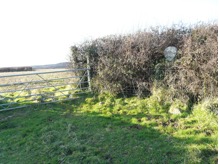 Crosses exist still at Lizard, Trelanvean, Predannack, Cury, St Anthony, Gunwalloe. Some give the impression of being herded into churchyards and there is a possibility that they may predate the church, as do the lanns, early raised burial sites where many churches were latecomers. Others found shelter at the time of the Reformation in high status estates; a few were buried in churchyards or incorporated in the fabric of buildings; some were re-used as gateposts.
Crosses exist still at Lizard, Trelanvean, Predannack, Cury, St Anthony, Gunwalloe. Some give the impression of being herded into churchyards and there is a possibility that they may predate the church, as do the lanns, early raised burial sites where many churches were latecomers. Others found shelter at the time of the Reformation in high status estates; a few were buried in churchyards or incorporated in the fabric of buildings; some were re-used as gateposts.
However, we have textual evidence which suggests there were more crosses transhistorically: two Anglo Saxon Charters, dated AD967, name Crousgrua³ as a waypoint, after which Crousa Downs may well be named: and, thanks to the considerable intellectual effort that went into recording field names in the mid C19th, we are supplied with various hints of an earlier landscape. In the St Keverne apportionment to the Tithe Map 9 fields bearing the name Grouse are listed, an indication that a stone cross stood in near proximity even if there is no current trace⁴; 3 more have Crous in the title and 26 carry the word Cross. These latter often refer to a road crossing, only some of which had an early cross as a navigation aid.
Other parishes in the Meneage reveal ghost epigraphy⁵ in their field names: 10 in Manaccan, 4 in St Anthony, 3 in St Martin, 6 each in Mawgan, Cury, and Ruan Major, 1 in Ruan Minor, 4 in Landewednack, 5 in Gunwalloe, 2 in Grade and a possible half dozen in Mullion depending upon how the original dictation was transcribed, the attribution of mystical letter sequences and possible C20th digital typos.
We are short of quoits but, uniquely, Trelease has a Great and Little Clapper Close – too high on a hill to refer to a bridge. I suggest the clapper was the roof of a vanished quoit. Sliding into this category is the 3 Brothers of Grugwith whose low capstone has interesting cracking probably fire induced over a long period. It also bears decoration in the form of cup marks, rare in Cornwall. 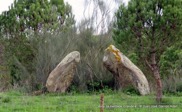 Nearby, on the edge of Mediaeval and Prehistoric field systems at Kestle Merris, two gabbro Crusairs incline towards each other not quite touching at the top. Geologists declare this is not a natural formation: archaeologists are reluctant to give it monument status. Known locally as The Chief’s Tomb it has similarities with the Portuguese Anta de Herdade which translates as Groundhog. Anta occurs in the names of many Portuguese quoits.
Nearby, on the edge of Mediaeval and Prehistoric field systems at Kestle Merris, two gabbro Crusairs incline towards each other not quite touching at the top. Geologists declare this is not a natural formation: archaeologists are reluctant to give it monument status. Known locally as The Chief’s Tomb it has similarities with the Portuguese Anta de Herdade which translates as Groundhog. Anta occurs in the names of many Portuguese quoits.
A few standing stones remain; Dry Tree resurrected last century: Tremenhere: Crousa: Hyrven. An C18th plan of Traboe Manor displays the location of Vounder Tudor⁶. A field called Long Stone at Trelanvean reveals the site of another.
Inscribed stones are necessarily granite and vanishingly rare on this shard of weird geology. If the Historic Environment Records are to be believed the example at Mawgan⁷ was preserved by its being converted into a cross shaft. A strong rumour of another, masquerading as a gatepost has yet to be deciphered.
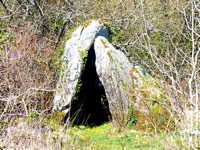 Granite is the preferred material for 99% of known Cornish crosses. Where available it is also a convenient fabric of gateposts. I suggest that late Mediaeval enclosure of fields provided a requirement for gateposts and the sole convenient supply of granite on The Lizard at the time was to be found in crosses which had lost the viability of their original intent and fallen into desuetude. Granite gateposts lacking the telltale marks of wedge and groove or plug and feather⁸ splitting may be enjoying a different afterlife from the one associated with the former monuments.
Granite is the preferred material for 99% of known Cornish crosses. Where available it is also a convenient fabric of gateposts. I suggest that late Mediaeval enclosure of fields provided a requirement for gateposts and the sole convenient supply of granite on The Lizard at the time was to be found in crosses which had lost the viability of their original intent and fallen into desuetude. Granite gateposts lacking the telltale marks of wedge and groove or plug and feather⁸ splitting may be enjoying a different afterlife from the one associated with the former monuments.
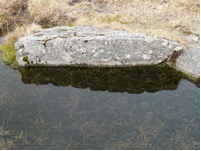 |
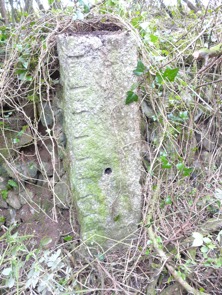 |
It comes down to geology, the availability of raw materials and the indigenous Cornish reluctance to travel more than 3 miles for them before the age of roads and the firepower of steam, plus an inextinguishable thrifty attention to recycling. How the crosses made it here in the first place is another story.
¹ Turner S; Making a Christian Landscape
² ibid, P165
³ Cornish crous `cross’ + gruah `hag, witch’; S832; S755; Hooke 1994
⁴ Pers comment Andrew Langdon
⁵ A term originally used to recall a lost metallic inscription from the mounting holes on the supports. It’s a nice term and deserves this expansion of its meaning
⁶ CRO ref G/1868/2 available, in brief, on line
⁷ late 6th century, ‘CNEGUMI FILI GENAIVS’ (Cnegumus, son of Genaius)
⁸ W and G technique of chiselling a series of grooves and hammering in wedges, which could be wood, forced to expand when wetted – mainly pre 1800: P and F require a line of drilled holes and specialist tools, largely taking over post 1800 (an open ended way of dating granite)
Published: Feb 2018
Author: Chris Harris (Meneage Archaeology Contribution)
